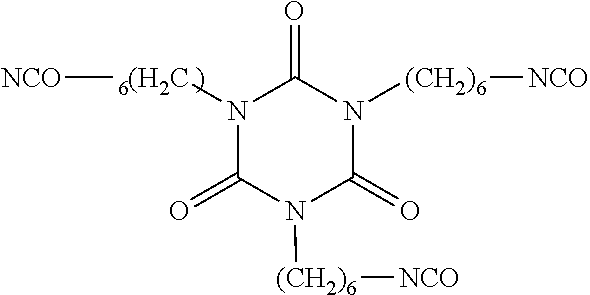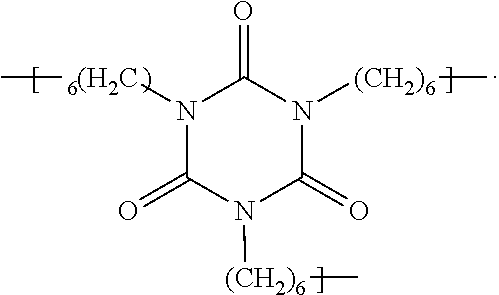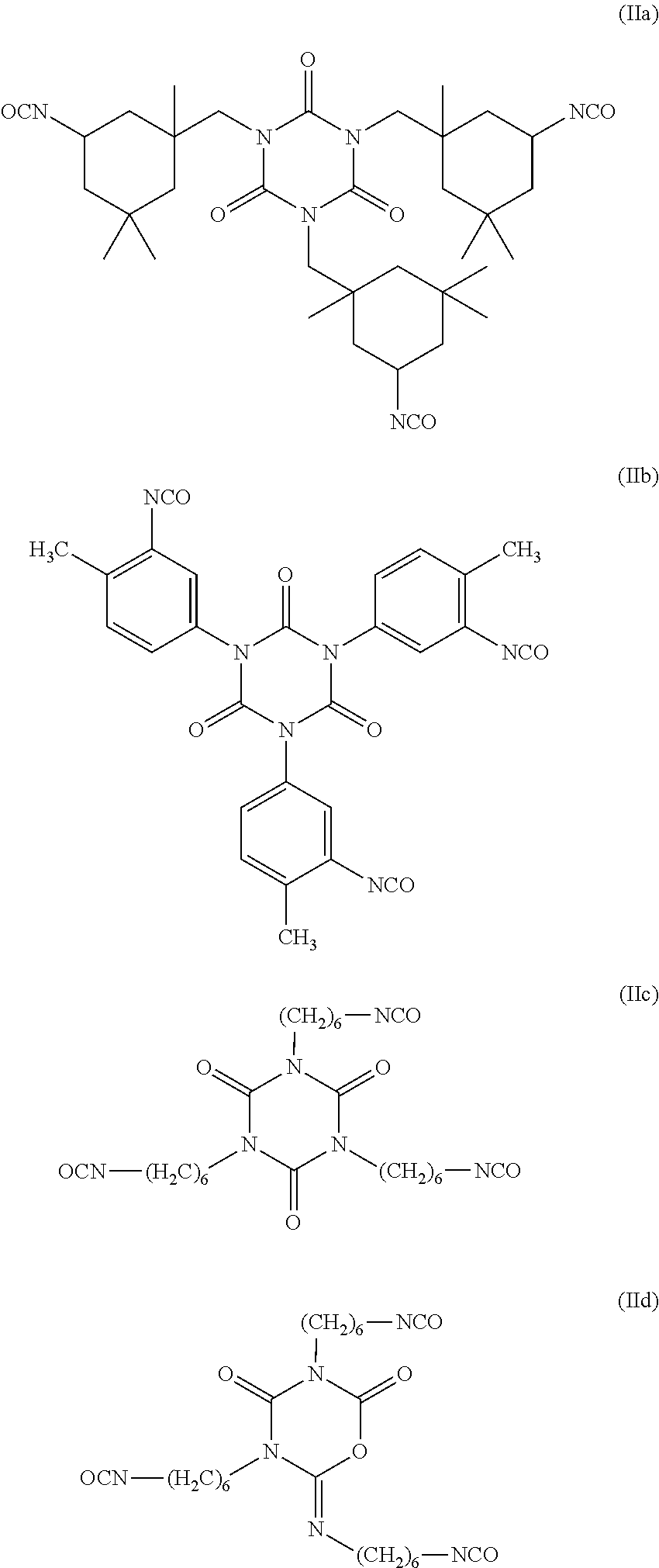Fluorinated ethoxylated polyurethanes
a technology of fluorinated ethoxylated polyurethane and polyurethane, which is applied in the direction of polishing compositions, sealing/packing, and well accessories, etc., can solve the problems of reducing or eliminating the ability to exhibit effective surface properties, and many surfactants known for low foaming, such as phosphates, are not stable in acidic, basic or brine formulations
- Summary
- Abstract
- Description
- Claims
- Application Information
AI Technical Summary
Benefits of technology
Problems solved by technology
Method used
Image
Examples
example 1
[0054]Example 1 was prepared by adding fluoroethoxylated alcohol, CF3(CF2)5CH2CH2—O—(CH2CH2O)nCH2CH2OH, where n is 2.7 to 3.7 (50.0 g, commercially available from E. I. du Pont de Nemours and Company, Wilmington, Del.) to a 4-neck reaction flask equipped with a reflux condenser, additional funnel and overhead stirring. Iron chloride (0.39 g) in methyl isobutylketone (MIBK, 5 g) was added and the reaction flask was heated to 85° C. Isophorone diisocyante (5.05 g, commercially available from Bayer Corporation, Pittsburgh, Pa. as DESMODUR I) was dissolved in MIBK (30 g) and added to the reaction flask dropwise over 4 hrs. The mixture was tested for active isocyanates. If active isocyanates were present, additional fluoroethoxylated alcohol was added. The mixture was then allowed to react overnight at 85° C. The reaction mixture was then cooled, and solvent (MIBK) was distilled at 70° C. under vacuum at 100 mmHg (13.3 kPa). The final product was analyzed to be
wherein n is 2.7 to 3.7. Ex...
example 2
[0055]Example 2 was prepared by adding fluoroethoxylated alcohol, CF3(CF2)5CH2CH2—O—(CH2CH2O)nCH2CH2OH, where n is 4.6 to 6.1 (58.0 g, commercially available from E. I. du Pont de Nemours and Company, Wilmington, Del.) to a 4-neck reaction flask equipped with a reflux condenser, additional funnel and overhead stirring. Iron chloride (0.39 g) in methyl isobutylketone (MIBK, 5 g) was added and the reaction flask was heated to 85° C. Isophorone diisocyante (5.05 g, commercially available from Bayer Corporation, Pittsburgh, Pa. as DESMODUR I) was dissolved in MIBK (30 g) and added to the reaction flask dropwise over 4 hrs. The mixture was tested for active isocyanates. If active isocyanates were present, additional fluoroethoxylated alcohol was added. The mixture was then allowed to react overnight at 85° C. The reaction mixture was then cooled, and solvent (MIBK) was distilled at 70° C. under vacuum at 100 mmHg (13.3 kPa). The final product was analyzed to be
wherein n is 4.7 to 5.7. Ex...
example 3
[0056]Example 3 was prepared by adding fluoroethoxylated alcohol, CF3(CF2)5CH2CH2—O—(CH2CH2O)nCH2CH2OH, where n is 4.6 to 6.1 (1000.0 g, commercially available from E. I. du Pont de Nemours and Company, Wilmington, Del.) to a 4-neck reaction flask equipped with a reflux condenser, additional funnel and overhead stirring. Iron chloride (0.040 g) in methyl isobutylketone (MIBK, 5 g) was added and the reaction flask was heated to 85° C. Hexamethylene diisocyanate (20.0 g, commercially available from Bayer Corporation, Pittsburgh, Pa. as DESMODUR H) was dissolved in MIBK (30 g) and added to the reaction flask dropwise over 4 hrs. The mixture was tested for active isocyanates. If active isocyanates were present, additional fluoroethoxylated alcohol was added. The mixture was then allowed to react overnight at 85° C. The reaction mixture was then cooled, and solvent (MIBK) was distilled at 70° C. under vacuum at 100 mmHg (13.3 kPa). The final product was analyzed to be CF3(CF2)5CH2CH2—O—(...
PUM
| Property | Measurement | Unit |
|---|---|---|
| surface tension | aaaaa | aaaaa |
| surface behavior | aaaaa | aaaaa |
| concentration | aaaaa | aaaaa |
Abstract
Description
Claims
Application Information
 Login to View More
Login to View More - R&D
- Intellectual Property
- Life Sciences
- Materials
- Tech Scout
- Unparalleled Data Quality
- Higher Quality Content
- 60% Fewer Hallucinations
Browse by: Latest US Patents, China's latest patents, Technical Efficacy Thesaurus, Application Domain, Technology Topic, Popular Technical Reports.
© 2025 PatSnap. All rights reserved.Legal|Privacy policy|Modern Slavery Act Transparency Statement|Sitemap|About US| Contact US: help@patsnap.com



